Comprehensive Change Management Report: IOOF Holdings Limited
VerifiedAdded on 2022/11/30
|21
|4911
|208
Report
AI Summary
This report provides a comprehensive analysis of a change management program implemented at IOOF Holdings Limited, focusing on the company's response to the recommendations of the Australian Royal Commission. The report details the chosen change program centered on customer service, operational management, and the redefining of shared organizational values. It explores the rationale behind these changes, emphasizing their financial and cultural value. The analysis incorporates two key change management models: the McKinsey 7-S model and Lewin's change management model, providing a structured approach to implementation. The report also addresses stakeholder engagement, the management of employee resistance, performance measurement, and strategies for embedding sustainable changes. The conclusion highlights the critical importance of effective change management for organizational development and success.
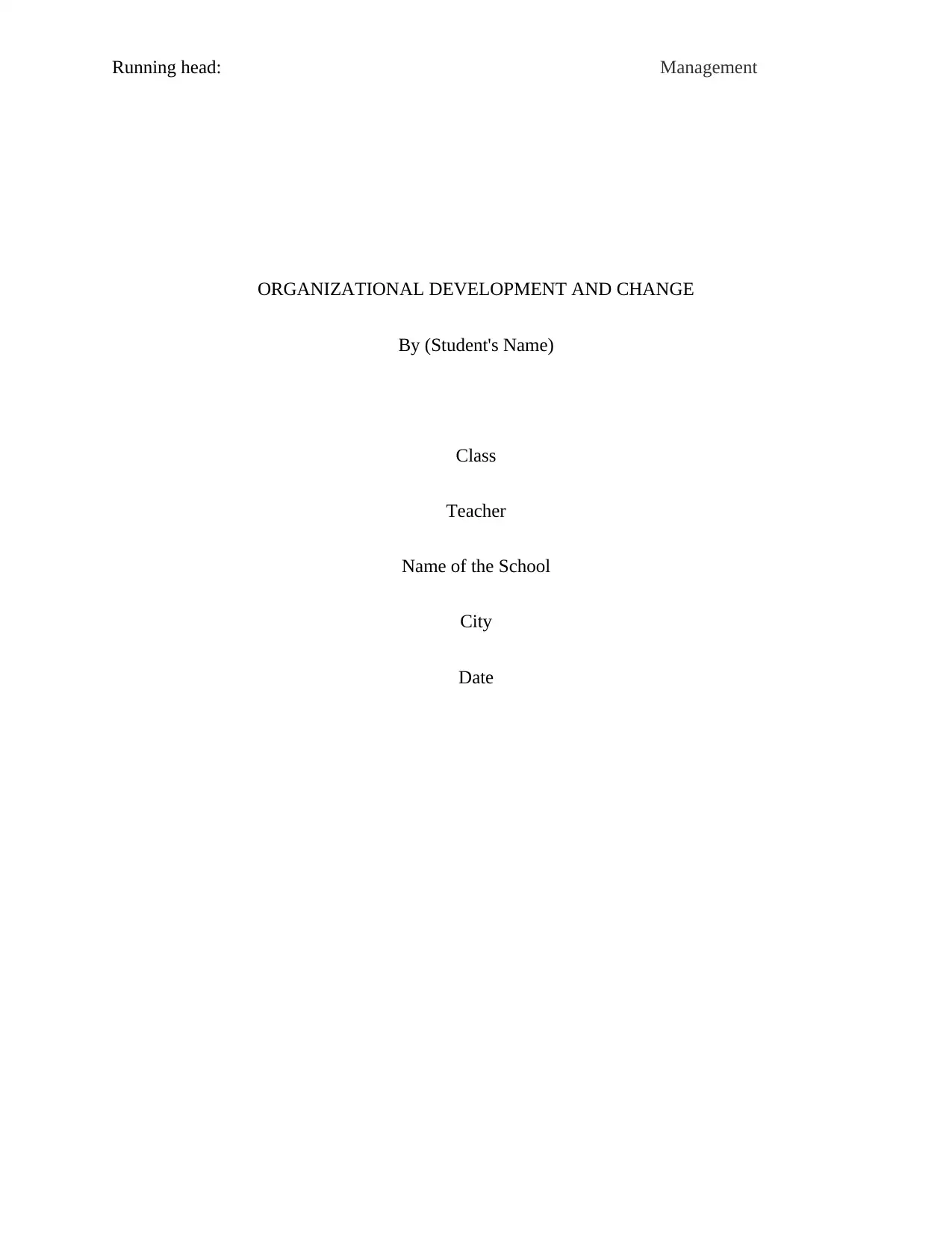
Running head: Management
ORGANIZATIONAL DEVELOPMENT AND CHANGE
By (Student's Name)
Class
Teacher
Name of the School
City
Date
ORGANIZATIONAL DEVELOPMENT AND CHANGE
By (Student's Name)
Class
Teacher
Name of the School
City
Date
Paraphrase This Document
Need a fresh take? Get an instant paraphrase of this document with our AI Paraphraser
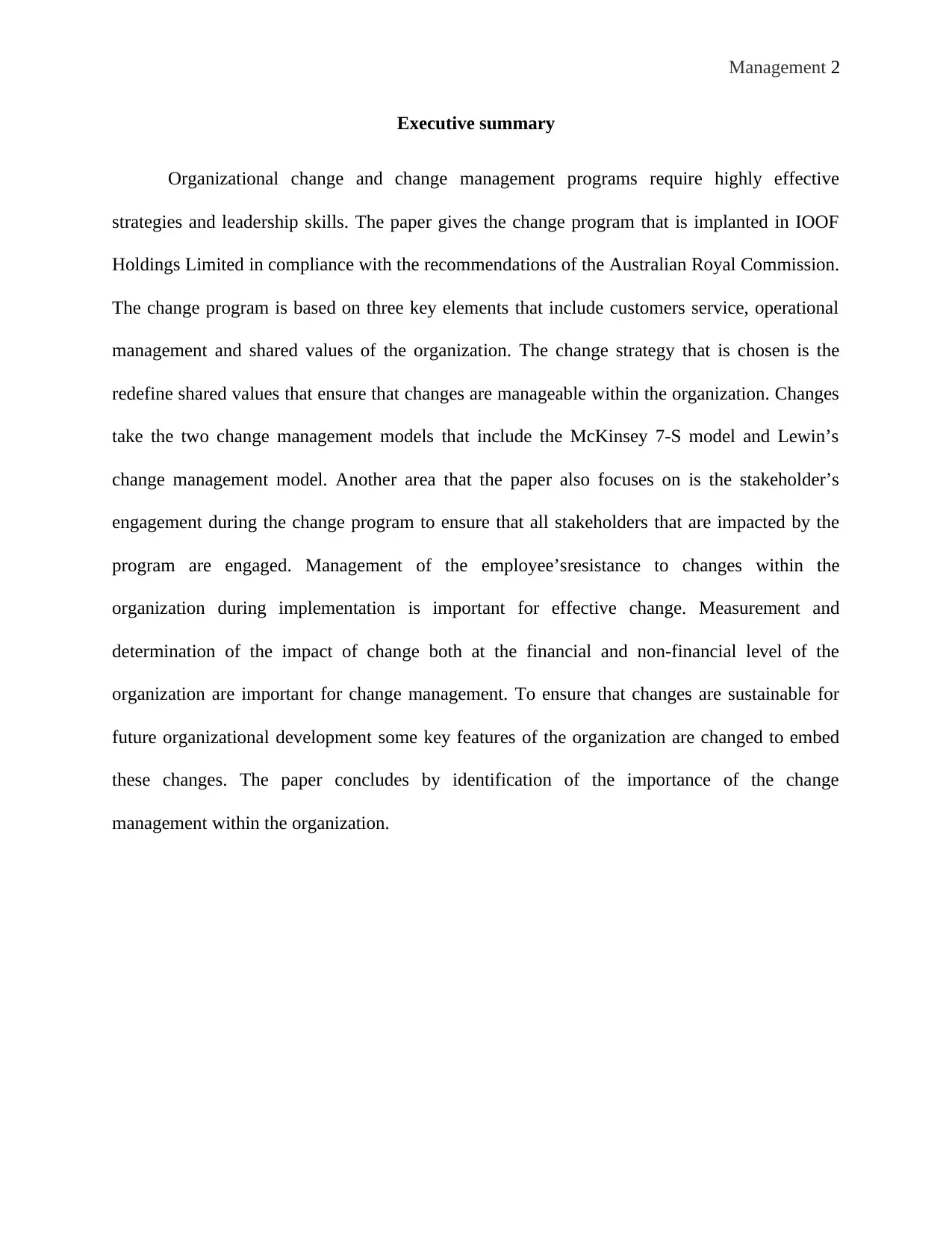
Management 2
Executive summary
Organizational change and change management programs require highly effective
strategies and leadership skills. The paper gives the change program that is implanted in IOOF
Holdings Limited in compliance with the recommendations of the Australian Royal Commission.
The change program is based on three key elements that include customers service, operational
management and shared values of the organization. The change strategy that is chosen is the
redefine shared values that ensure that changes are manageable within the organization. Changes
take the two change management models that include the McKinsey 7-S model and Lewin’s
change management model. Another area that the paper also focuses on is the stakeholder’s
engagement during the change program to ensure that all stakeholders that are impacted by the
program are engaged. Management of the employee’sresistance to changes within the
organization during implementation is important for effective change. Measurement and
determination of the impact of change both at the financial and non-financial level of the
organization are important for change management. To ensure that changes are sustainable for
future organizational development some key features of the organization are changed to embed
these changes. The paper concludes by identification of the importance of the change
management within the organization.
Executive summary
Organizational change and change management programs require highly effective
strategies and leadership skills. The paper gives the change program that is implanted in IOOF
Holdings Limited in compliance with the recommendations of the Australian Royal Commission.
The change program is based on three key elements that include customers service, operational
management and shared values of the organization. The change strategy that is chosen is the
redefine shared values that ensure that changes are manageable within the organization. Changes
take the two change management models that include the McKinsey 7-S model and Lewin’s
change management model. Another area that the paper also focuses on is the stakeholder’s
engagement during the change program to ensure that all stakeholders that are impacted by the
program are engaged. Management of the employee’sresistance to changes within the
organization during implementation is important for effective change. Measurement and
determination of the impact of change both at the financial and non-financial level of the
organization are important for change management. To ensure that changes are sustainable for
future organizational development some key features of the organization are changed to embed
these changes. The paper concludes by identification of the importance of the change
management within the organization.
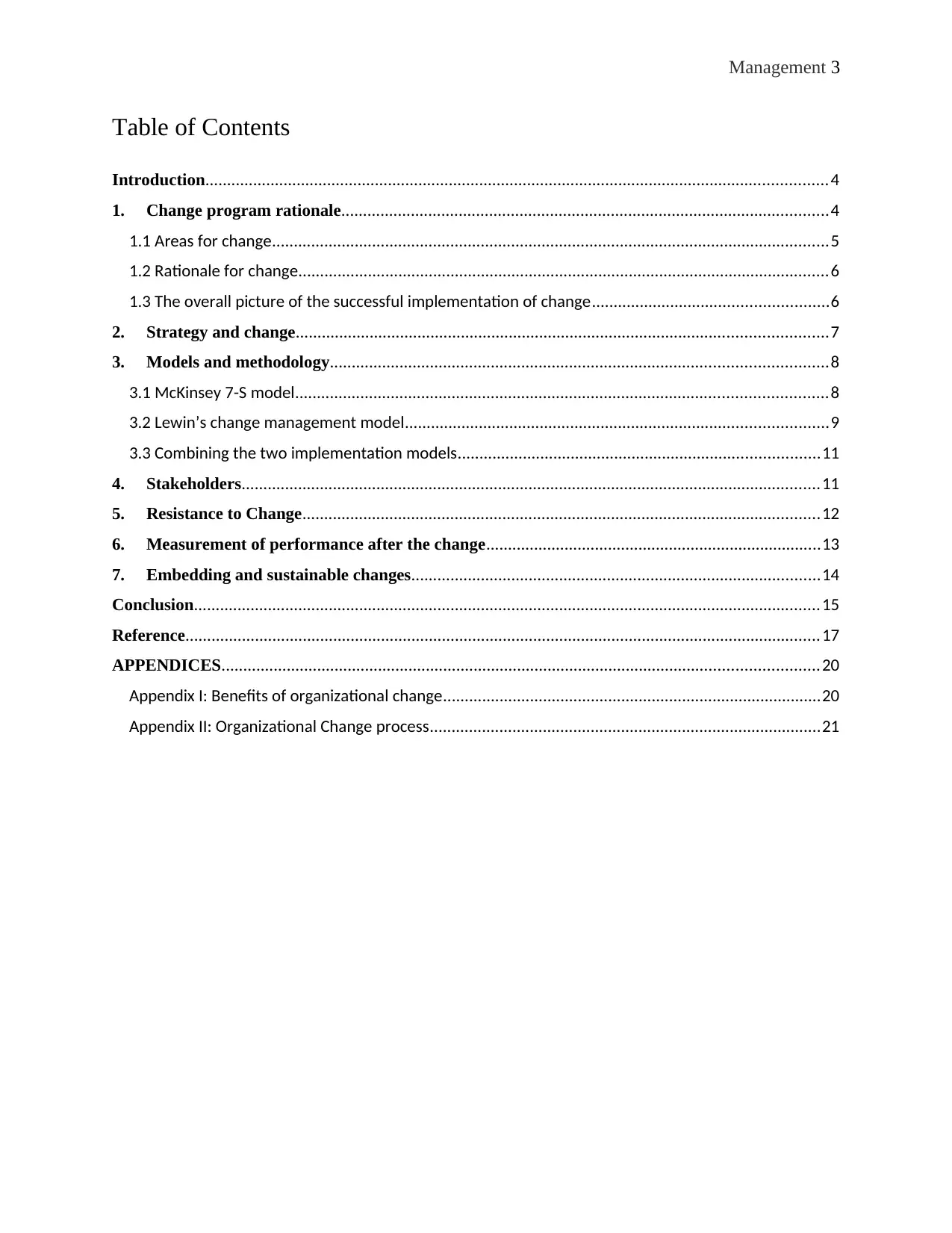
Management 3
Table of Contents
Introduction...............................................................................................................................................4
1. Change program rationale................................................................................................................4
1.1 Areas for change................................................................................................................................5
1.2 Rationale for change..........................................................................................................................6
1.3 The overall picture of the successful implementation of change......................................................6
2. Strategy and change..........................................................................................................................7
3. Models and methodology..................................................................................................................8
3.1 McKinsey 7-S model..........................................................................................................................8
3.2 Lewin’s change management model.................................................................................................9
3.3 Combining the two implementation models...................................................................................11
4. Stakeholders.....................................................................................................................................11
5. Resistance to Change.......................................................................................................................12
6. Measurement of performance after the change.............................................................................13
7. Embedding and sustainable changes..............................................................................................14
Conclusion................................................................................................................................................15
Reference..................................................................................................................................................17
APPENDICES.........................................................................................................................................20
Appendix I: Benefits of organizational change.......................................................................................20
Appendix II: Organizational Change process..........................................................................................21
Table of Contents
Introduction...............................................................................................................................................4
1. Change program rationale................................................................................................................4
1.1 Areas for change................................................................................................................................5
1.2 Rationale for change..........................................................................................................................6
1.3 The overall picture of the successful implementation of change......................................................6
2. Strategy and change..........................................................................................................................7
3. Models and methodology..................................................................................................................8
3.1 McKinsey 7-S model..........................................................................................................................8
3.2 Lewin’s change management model.................................................................................................9
3.3 Combining the two implementation models...................................................................................11
4. Stakeholders.....................................................................................................................................11
5. Resistance to Change.......................................................................................................................12
6. Measurement of performance after the change.............................................................................13
7. Embedding and sustainable changes..............................................................................................14
Conclusion................................................................................................................................................15
Reference..................................................................................................................................................17
APPENDICES.........................................................................................................................................20
Appendix I: Benefits of organizational change.......................................................................................20
Appendix II: Organizational Change process..........................................................................................21
⊘ This is a preview!⊘
Do you want full access?
Subscribe today to unlock all pages.

Trusted by 1+ million students worldwide
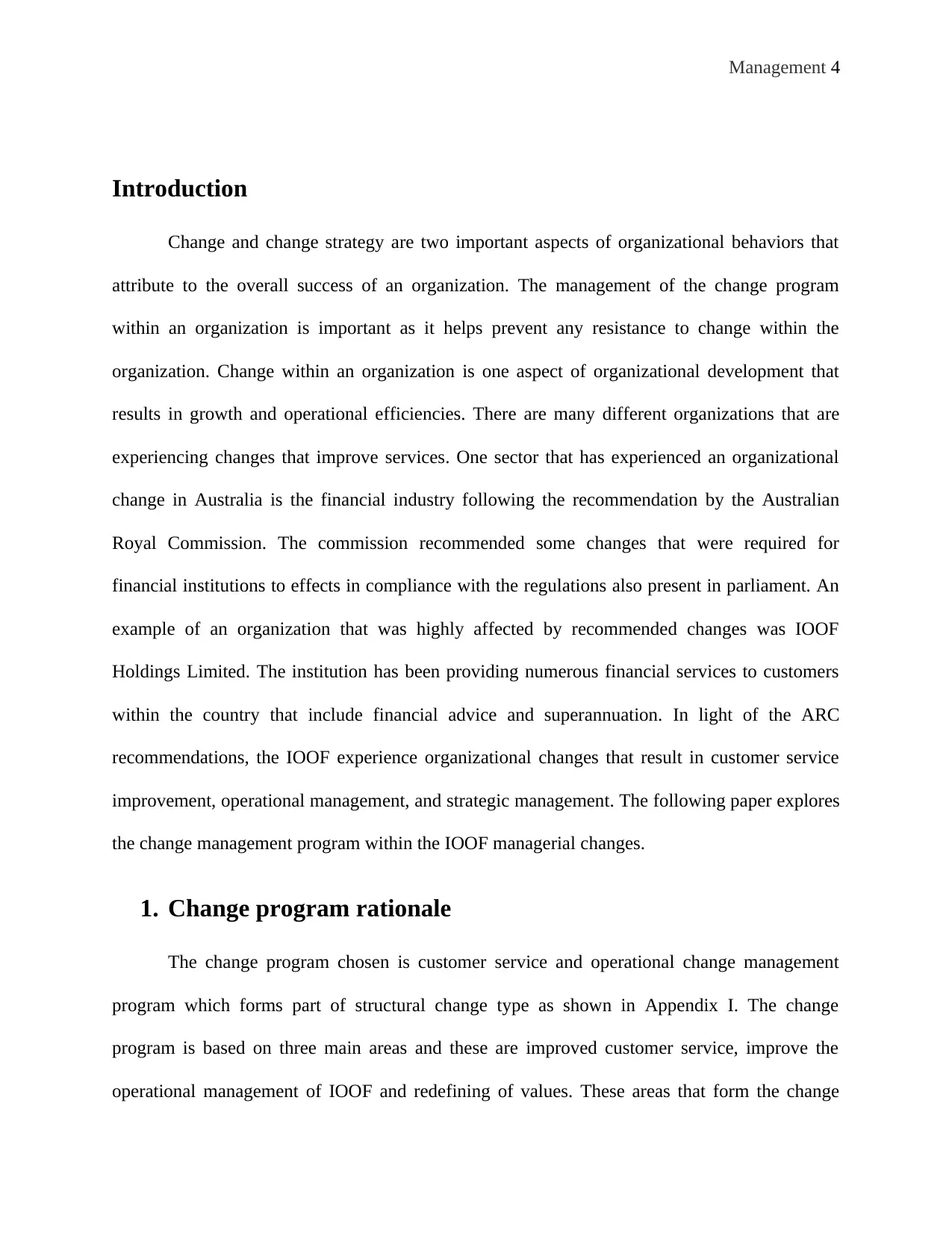
Management 4
Introduction
Change and change strategy are two important aspects of organizational behaviors that
attribute to the overall success of an organization. The management of the change program
within an organization is important as it helps prevent any resistance to change within the
organization. Change within an organization is one aspect of organizational development that
results in growth and operational efficiencies. There are many different organizations that are
experiencing changes that improve services. One sector that has experienced an organizational
change in Australia is the financial industry following the recommendation by the Australian
Royal Commission. The commission recommended some changes that were required for
financial institutions to effects in compliance with the regulations also present in parliament. An
example of an organization that was highly affected by recommended changes was IOOF
Holdings Limited. The institution has been providing numerous financial services to customers
within the country that include financial advice and superannuation. In light of the ARC
recommendations, the IOOF experience organizational changes that result in customer service
improvement, operational management, and strategic management. The following paper explores
the change management program within the IOOF managerial changes.
1. Change program rationale
The change program chosen is customer service and operational change management
program which forms part of structural change type as shown in Appendix I. The change
program is based on three main areas and these are improved customer service, improve the
operational management of IOOF and redefining of values. These areas that form the change
Introduction
Change and change strategy are two important aspects of organizational behaviors that
attribute to the overall success of an organization. The management of the change program
within an organization is important as it helps prevent any resistance to change within the
organization. Change within an organization is one aspect of organizational development that
results in growth and operational efficiencies. There are many different organizations that are
experiencing changes that improve services. One sector that has experienced an organizational
change in Australia is the financial industry following the recommendation by the Australian
Royal Commission. The commission recommended some changes that were required for
financial institutions to effects in compliance with the regulations also present in parliament. An
example of an organization that was highly affected by recommended changes was IOOF
Holdings Limited. The institution has been providing numerous financial services to customers
within the country that include financial advice and superannuation. In light of the ARC
recommendations, the IOOF experience organizational changes that result in customer service
improvement, operational management, and strategic management. The following paper explores
the change management program within the IOOF managerial changes.
1. Change program rationale
The change program chosen is customer service and operational change management
program which forms part of structural change type as shown in Appendix I. The change
program is based on three main areas and these are improved customer service, improve the
operational management of IOOF and redefining of values. These areas that form the change
Paraphrase This Document
Need a fresh take? Get an instant paraphrase of this document with our AI Paraphraser
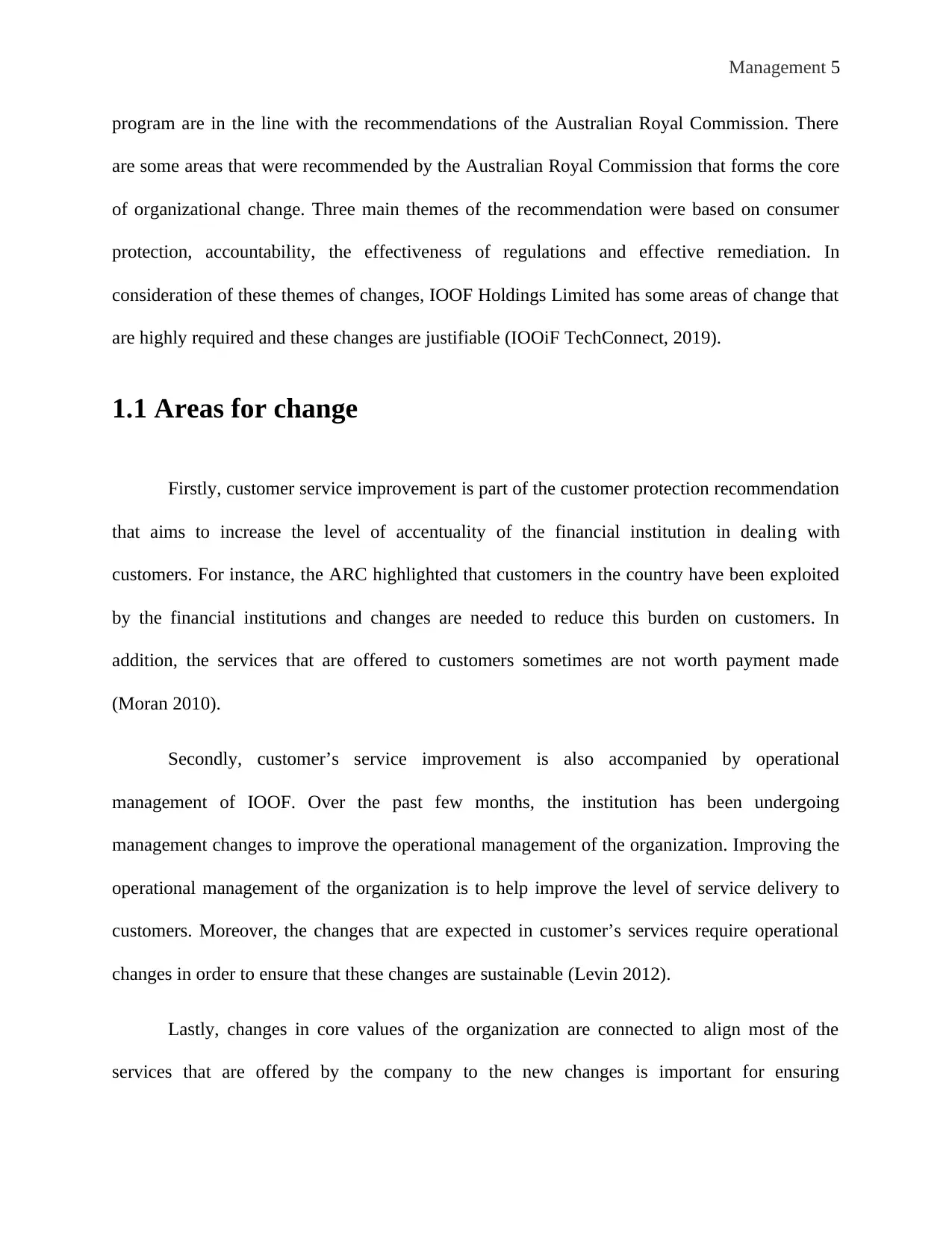
Management 5
program are in the line with the recommendations of the Australian Royal Commission. There
are some areas that were recommended by the Australian Royal Commission that forms the core
of organizational change. Three main themes of the recommendation were based on consumer
protection, accountability, the effectiveness of regulations and effective remediation. In
consideration of these themes of changes, IOOF Holdings Limited has some areas of change that
are highly required and these changes are justifiable (IOOiF TechConnect, 2019).
1.1 Areas for change
Firstly, customer service improvement is part of the customer protection recommendation
that aims to increase the level of accentuality of the financial institution in dealing with
customers. For instance, the ARC highlighted that customers in the country have been exploited
by the financial institutions and changes are needed to reduce this burden on customers. In
addition, the services that are offered to customers sometimes are not worth payment made
(Moran 2010).
Secondly, customer’s service improvement is also accompanied by operational
management of IOOF. Over the past few months, the institution has been undergoing
management changes to improve the operational management of the organization. Improving the
operational management of the organization is to help improve the level of service delivery to
customers. Moreover, the changes that are expected in customer’s services require operational
changes in order to ensure that these changes are sustainable (Levin 2012).
Lastly, changes in core values of the organization are connected to align most of the
services that are offered by the company to the new changes is important for ensuring
program are in the line with the recommendations of the Australian Royal Commission. There
are some areas that were recommended by the Australian Royal Commission that forms the core
of organizational change. Three main themes of the recommendation were based on consumer
protection, accountability, the effectiveness of regulations and effective remediation. In
consideration of these themes of changes, IOOF Holdings Limited has some areas of change that
are highly required and these changes are justifiable (IOOiF TechConnect, 2019).
1.1 Areas for change
Firstly, customer service improvement is part of the customer protection recommendation
that aims to increase the level of accentuality of the financial institution in dealing with
customers. For instance, the ARC highlighted that customers in the country have been exploited
by the financial institutions and changes are needed to reduce this burden on customers. In
addition, the services that are offered to customers sometimes are not worth payment made
(Moran 2010).
Secondly, customer’s service improvement is also accompanied by operational
management of IOOF. Over the past few months, the institution has been undergoing
management changes to improve the operational management of the organization. Improving the
operational management of the organization is to help improve the level of service delivery to
customers. Moreover, the changes that are expected in customer’s services require operational
changes in order to ensure that these changes are sustainable (Levin 2012).
Lastly, changes in core values of the organization are connected to align most of the
services that are offered by the company to the new changes is important for ensuring
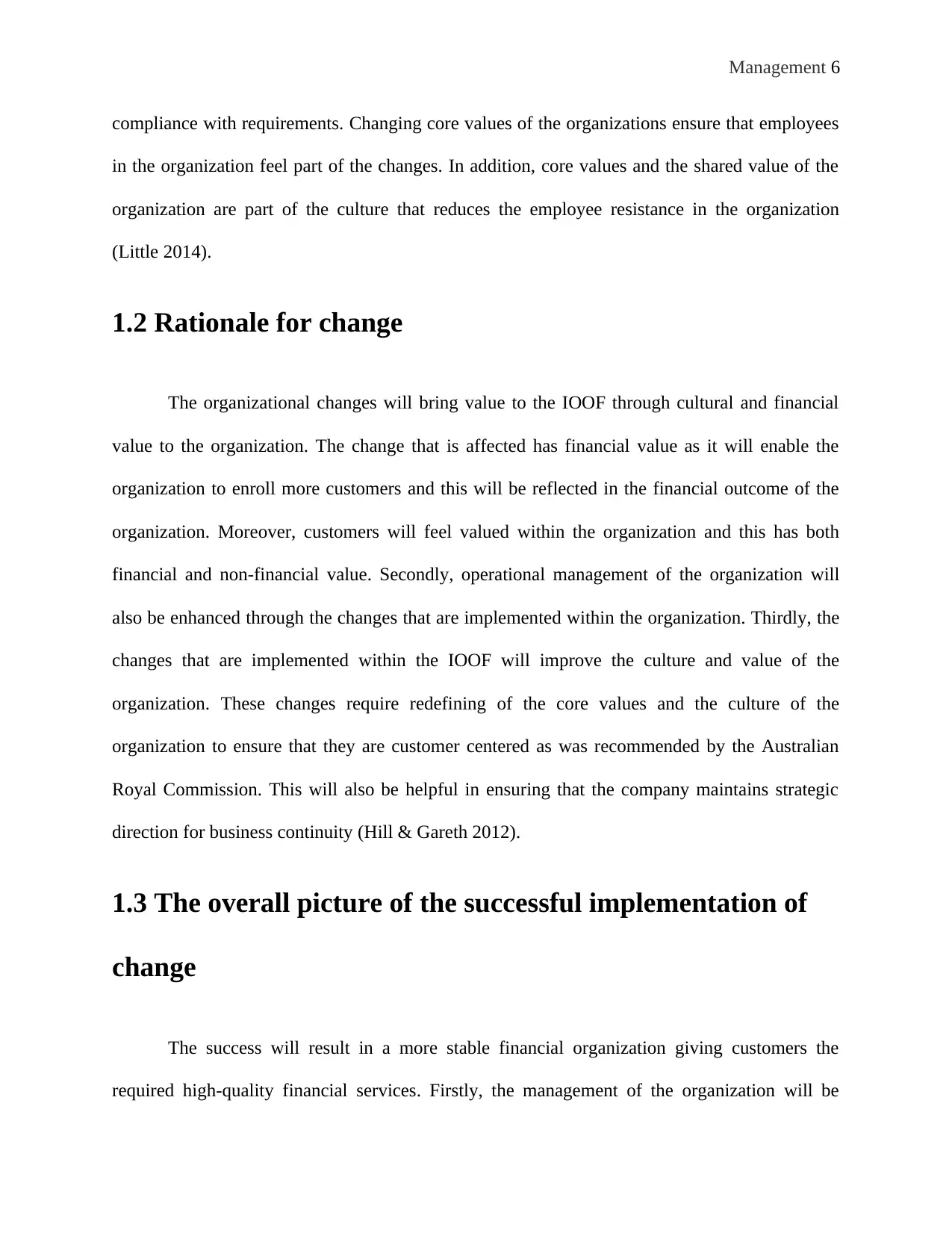
Management 6
compliance with requirements. Changing core values of the organizations ensure that employees
in the organization feel part of the changes. In addition, core values and the shared value of the
organization are part of the culture that reduces the employee resistance in the organization
(Little 2014).
1.2 Rationale for change
The organizational changes will bring value to the IOOF through cultural and financial
value to the organization. The change that is affected has financial value as it will enable the
organization to enroll more customers and this will be reflected in the financial outcome of the
organization. Moreover, customers will feel valued within the organization and this has both
financial and non-financial value. Secondly, operational management of the organization will
also be enhanced through the changes that are implemented within the organization. Thirdly, the
changes that are implemented within the IOOF will improve the culture and value of the
organization. These changes require redefining of the core values and the culture of the
organization to ensure that they are customer centered as was recommended by the Australian
Royal Commission. This will also be helpful in ensuring that the company maintains strategic
direction for business continuity (Hill & Gareth 2012).
1.3 The overall picture of the successful implementation of
change
The success will result in a more stable financial organization giving customers the
required high-quality financial services. Firstly, the management of the organization will be
compliance with requirements. Changing core values of the organizations ensure that employees
in the organization feel part of the changes. In addition, core values and the shared value of the
organization are part of the culture that reduces the employee resistance in the organization
(Little 2014).
1.2 Rationale for change
The organizational changes will bring value to the IOOF through cultural and financial
value to the organization. The change that is affected has financial value as it will enable the
organization to enroll more customers and this will be reflected in the financial outcome of the
organization. Moreover, customers will feel valued within the organization and this has both
financial and non-financial value. Secondly, operational management of the organization will
also be enhanced through the changes that are implemented within the organization. Thirdly, the
changes that are implemented within the IOOF will improve the culture and value of the
organization. These changes require redefining of the core values and the culture of the
organization to ensure that they are customer centered as was recommended by the Australian
Royal Commission. This will also be helpful in ensuring that the company maintains strategic
direction for business continuity (Hill & Gareth 2012).
1.3 The overall picture of the successful implementation of
change
The success will result in a more stable financial organization giving customers the
required high-quality financial services. Firstly, the management of the organization will be
⊘ This is a preview!⊘
Do you want full access?
Subscribe today to unlock all pages.

Trusted by 1+ million students worldwide
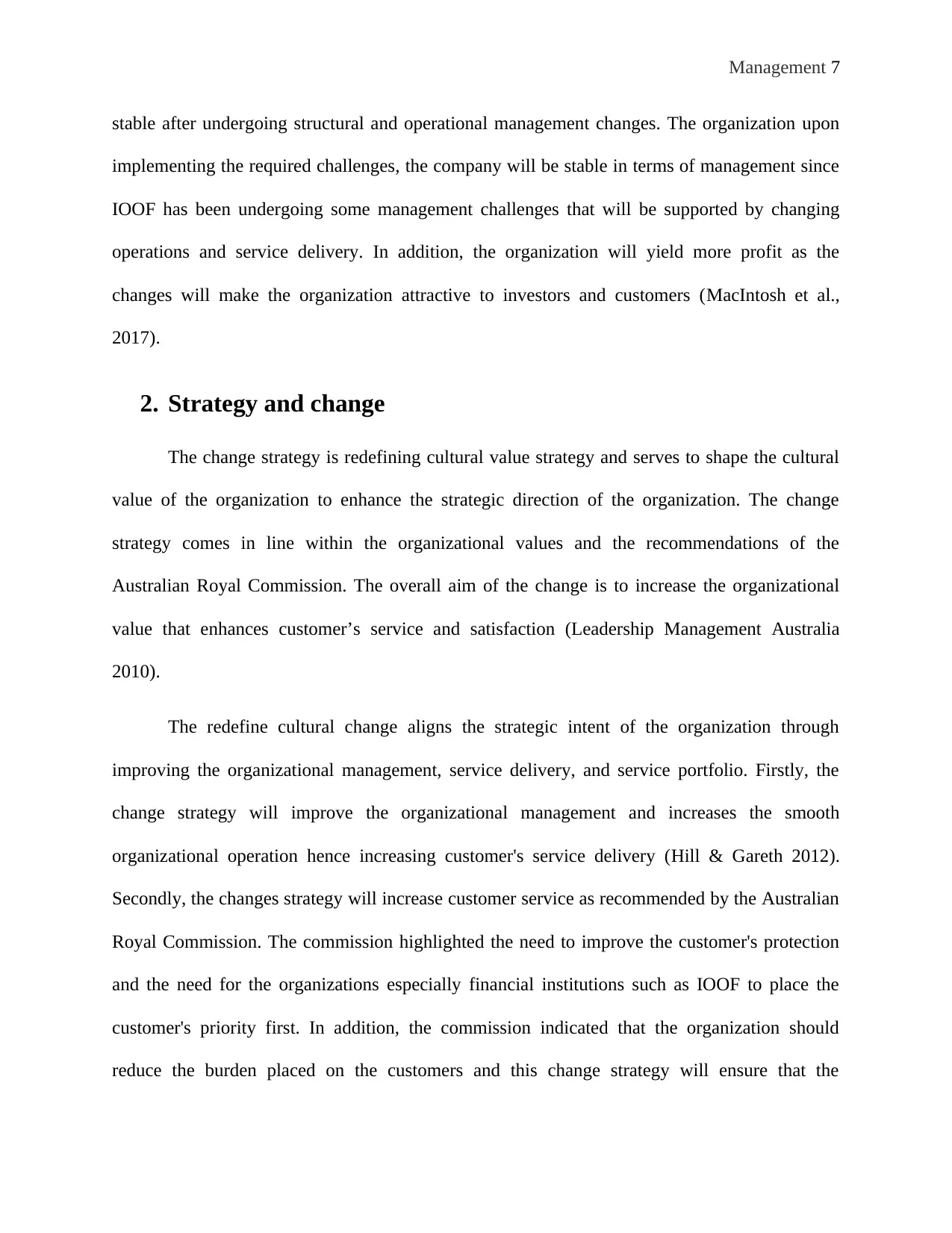
Management 7
stable after undergoing structural and operational management changes. The organization upon
implementing the required challenges, the company will be stable in terms of management since
IOOF has been undergoing some management challenges that will be supported by changing
operations and service delivery. In addition, the organization will yield more profit as the
changes will make the organization attractive to investors and customers (MacIntosh et al.,
2017).
2. Strategy and change
The change strategy is redefining cultural value strategy and serves to shape the cultural
value of the organization to enhance the strategic direction of the organization. The change
strategy comes in line within the organizational values and the recommendations of the
Australian Royal Commission. The overall aim of the change is to increase the organizational
value that enhances customer’s service and satisfaction (Leadership Management Australia
2010).
The redefine cultural change aligns the strategic intent of the organization through
improving the organizational management, service delivery, and service portfolio. Firstly, the
change strategy will improve the organizational management and increases the smooth
organizational operation hence increasing customer's service delivery (Hill & Gareth 2012).
Secondly, the changes strategy will increase customer service as recommended by the Australian
Royal Commission. The commission highlighted the need to improve the customer's protection
and the need for the organizations especially financial institutions such as IOOF to place the
customer's priority first. In addition, the commission indicated that the organization should
reduce the burden placed on the customers and this change strategy will ensure that the
stable after undergoing structural and operational management changes. The organization upon
implementing the required challenges, the company will be stable in terms of management since
IOOF has been undergoing some management challenges that will be supported by changing
operations and service delivery. In addition, the organization will yield more profit as the
changes will make the organization attractive to investors and customers (MacIntosh et al.,
2017).
2. Strategy and change
The change strategy is redefining cultural value strategy and serves to shape the cultural
value of the organization to enhance the strategic direction of the organization. The change
strategy comes in line within the organizational values and the recommendations of the
Australian Royal Commission. The overall aim of the change is to increase the organizational
value that enhances customer’s service and satisfaction (Leadership Management Australia
2010).
The redefine cultural change aligns the strategic intent of the organization through
improving the organizational management, service delivery, and service portfolio. Firstly, the
change strategy will improve the organizational management and increases the smooth
organizational operation hence increasing customer's service delivery (Hill & Gareth 2012).
Secondly, the changes strategy will increase customer service as recommended by the Australian
Royal Commission. The commission highlighted the need to improve the customer's protection
and the need for the organizations especially financial institutions such as IOOF to place the
customer's priority first. In addition, the commission indicated that the organization should
reduce the burden placed on the customers and this change strategy will ensure that the
Paraphrase This Document
Need a fresh take? Get an instant paraphrase of this document with our AI Paraphraser
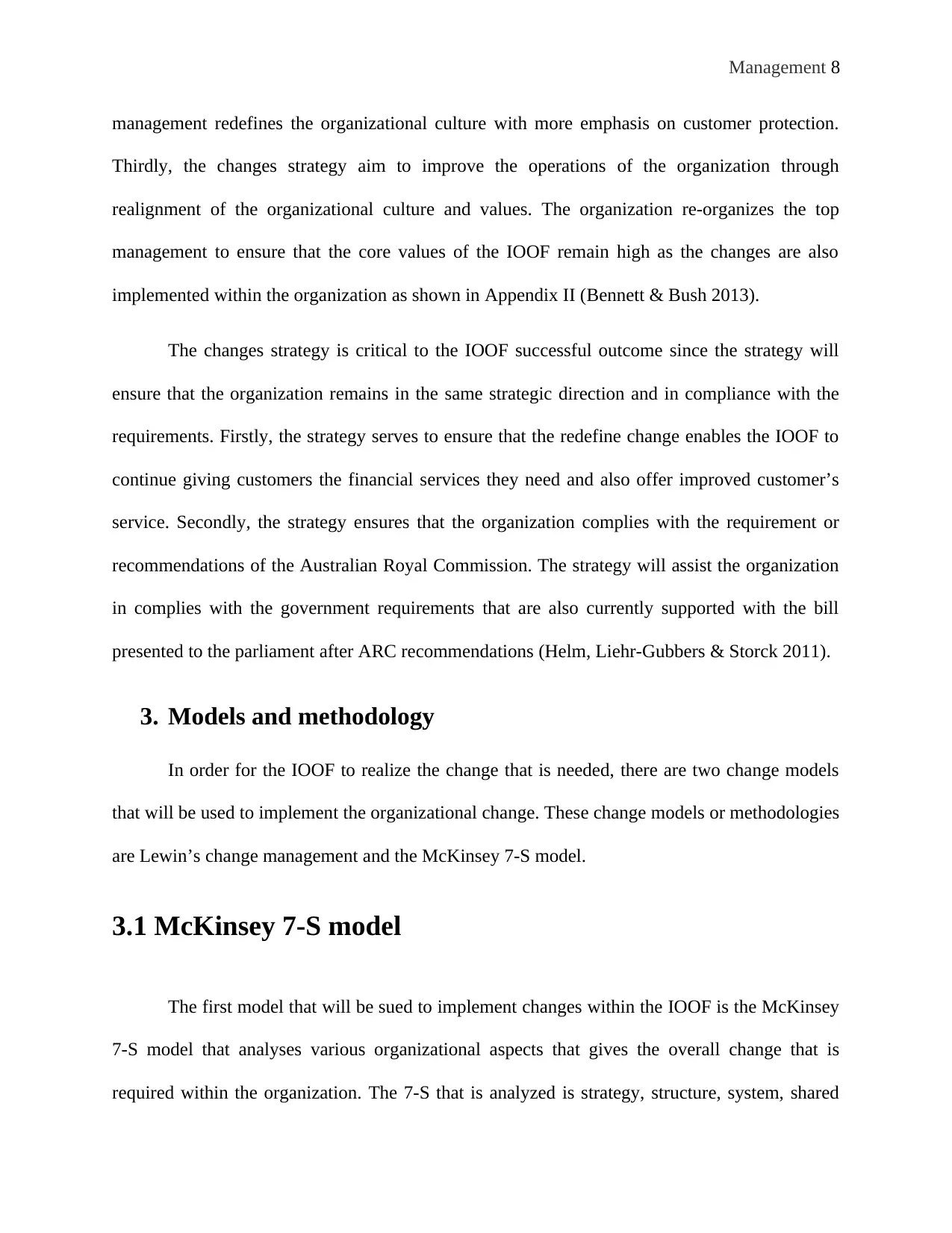
Management 8
management redefines the organizational culture with more emphasis on customer protection.
Thirdly, the changes strategy aim to improve the operations of the organization through
realignment of the organizational culture and values. The organization re-organizes the top
management to ensure that the core values of the IOOF remain high as the changes are also
implemented within the organization as shown in Appendix II (Bennett & Bush 2013).
The changes strategy is critical to the IOOF successful outcome since the strategy will
ensure that the organization remains in the same strategic direction and in compliance with the
requirements. Firstly, the strategy serves to ensure that the redefine change enables the IOOF to
continue giving customers the financial services they need and also offer improved customer’s
service. Secondly, the strategy ensures that the organization complies with the requirement or
recommendations of the Australian Royal Commission. The strategy will assist the organization
in complies with the government requirements that are also currently supported with the bill
presented to the parliament after ARC recommendations (Helm, Liehr-Gubbers & Storck 2011).
3. Models and methodology
In order for the IOOF to realize the change that is needed, there are two change models
that will be used to implement the organizational change. These change models or methodologies
are Lewin’s change management and the McKinsey 7-S model.
3.1 McKinsey 7-S model
The first model that will be sued to implement changes within the IOOF is the McKinsey
7-S model that analyses various organizational aspects that gives the overall change that is
required within the organization. The 7-S that is analyzed is strategy, structure, system, shared
management redefines the organizational culture with more emphasis on customer protection.
Thirdly, the changes strategy aim to improve the operations of the organization through
realignment of the organizational culture and values. The organization re-organizes the top
management to ensure that the core values of the IOOF remain high as the changes are also
implemented within the organization as shown in Appendix II (Bennett & Bush 2013).
The changes strategy is critical to the IOOF successful outcome since the strategy will
ensure that the organization remains in the same strategic direction and in compliance with the
requirements. Firstly, the strategy serves to ensure that the redefine change enables the IOOF to
continue giving customers the financial services they need and also offer improved customer’s
service. Secondly, the strategy ensures that the organization complies with the requirement or
recommendations of the Australian Royal Commission. The strategy will assist the organization
in complies with the government requirements that are also currently supported with the bill
presented to the parliament after ARC recommendations (Helm, Liehr-Gubbers & Storck 2011).
3. Models and methodology
In order for the IOOF to realize the change that is needed, there are two change models
that will be used to implement the organizational change. These change models or methodologies
are Lewin’s change management and the McKinsey 7-S model.
3.1 McKinsey 7-S model
The first model that will be sued to implement changes within the IOOF is the McKinsey
7-S model that analyses various organizational aspects that gives the overall change that is
required within the organization. The 7-S that is analyzed is strategy, structure, system, shared
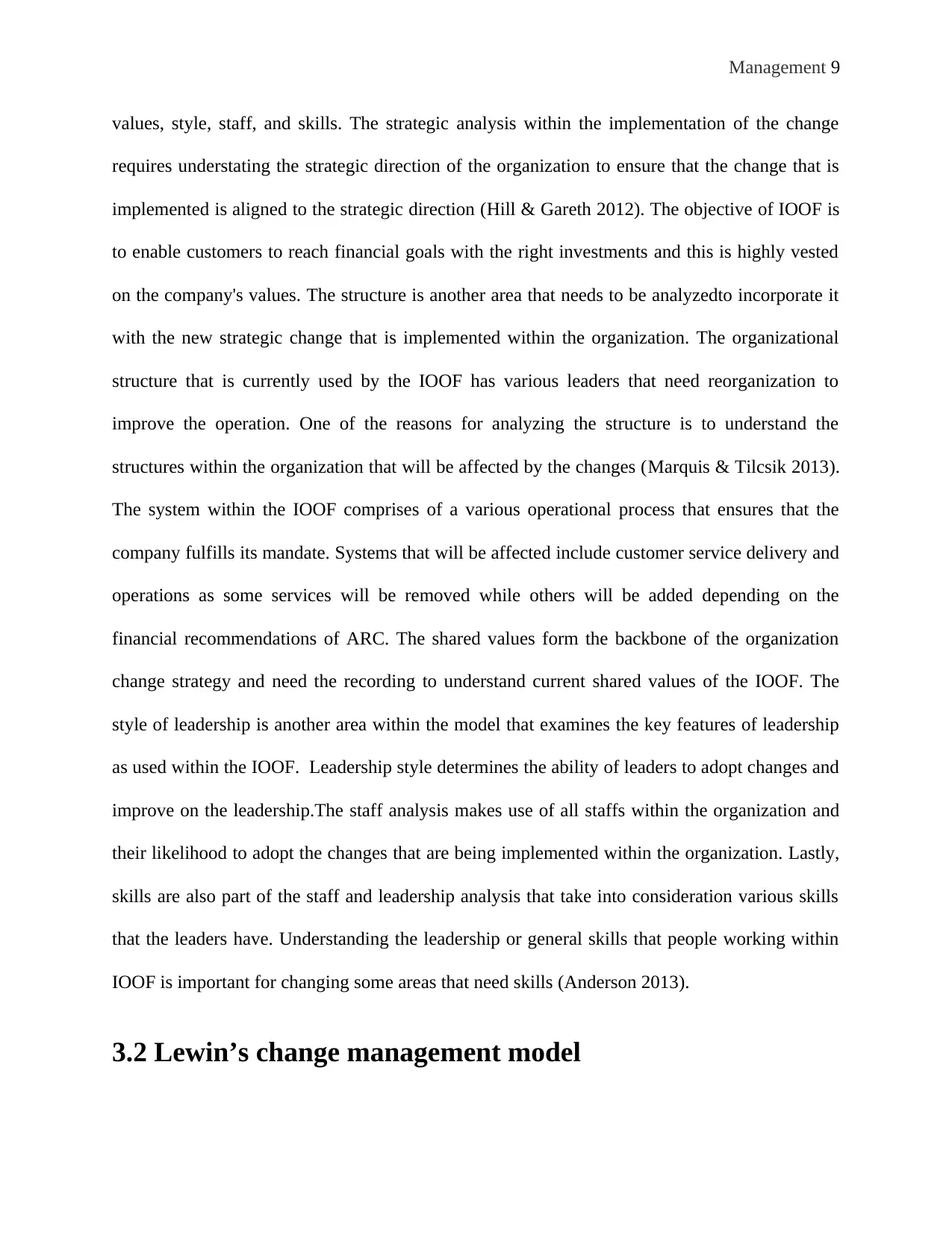
Management 9
values, style, staff, and skills. The strategic analysis within the implementation of the change
requires understating the strategic direction of the organization to ensure that the change that is
implemented is aligned to the strategic direction (Hill & Gareth 2012). The objective of IOOF is
to enable customers to reach financial goals with the right investments and this is highly vested
on the company's values. The structure is another area that needs to be analyzedto incorporate it
with the new strategic change that is implemented within the organization. The organizational
structure that is currently used by the IOOF has various leaders that need reorganization to
improve the operation. One of the reasons for analyzing the structure is to understand the
structures within the organization that will be affected by the changes (Marquis & Tilcsik 2013).
The system within the IOOF comprises of a various operational process that ensures that the
company fulfills its mandate. Systems that will be affected include customer service delivery and
operations as some services will be removed while others will be added depending on the
financial recommendations of ARC. The shared values form the backbone of the organization
change strategy and need the recording to understand current shared values of the IOOF. The
style of leadership is another area within the model that examines the key features of leadership
as used within the IOOF. Leadership style determines the ability of leaders to adopt changes and
improve on the leadership.The staff analysis makes use of all staffs within the organization and
their likelihood to adopt the changes that are being implemented within the organization. Lastly,
skills are also part of the staff and leadership analysis that take into consideration various skills
that the leaders have. Understanding the leadership or general skills that people working within
IOOF is important for changing some areas that need skills (Anderson 2013).
3.2 Lewin’s change management model
values, style, staff, and skills. The strategic analysis within the implementation of the change
requires understating the strategic direction of the organization to ensure that the change that is
implemented is aligned to the strategic direction (Hill & Gareth 2012). The objective of IOOF is
to enable customers to reach financial goals with the right investments and this is highly vested
on the company's values. The structure is another area that needs to be analyzedto incorporate it
with the new strategic change that is implemented within the organization. The organizational
structure that is currently used by the IOOF has various leaders that need reorganization to
improve the operation. One of the reasons for analyzing the structure is to understand the
structures within the organization that will be affected by the changes (Marquis & Tilcsik 2013).
The system within the IOOF comprises of a various operational process that ensures that the
company fulfills its mandate. Systems that will be affected include customer service delivery and
operations as some services will be removed while others will be added depending on the
financial recommendations of ARC. The shared values form the backbone of the organization
change strategy and need the recording to understand current shared values of the IOOF. The
style of leadership is another area within the model that examines the key features of leadership
as used within the IOOF. Leadership style determines the ability of leaders to adopt changes and
improve on the leadership.The staff analysis makes use of all staffs within the organization and
their likelihood to adopt the changes that are being implemented within the organization. Lastly,
skills are also part of the staff and leadership analysis that take into consideration various skills
that the leaders have. Understanding the leadership or general skills that people working within
IOOF is important for changing some areas that need skills (Anderson 2013).
3.2 Lewin’s change management model
⊘ This is a preview!⊘
Do you want full access?
Subscribe today to unlock all pages.

Trusted by 1+ million students worldwide
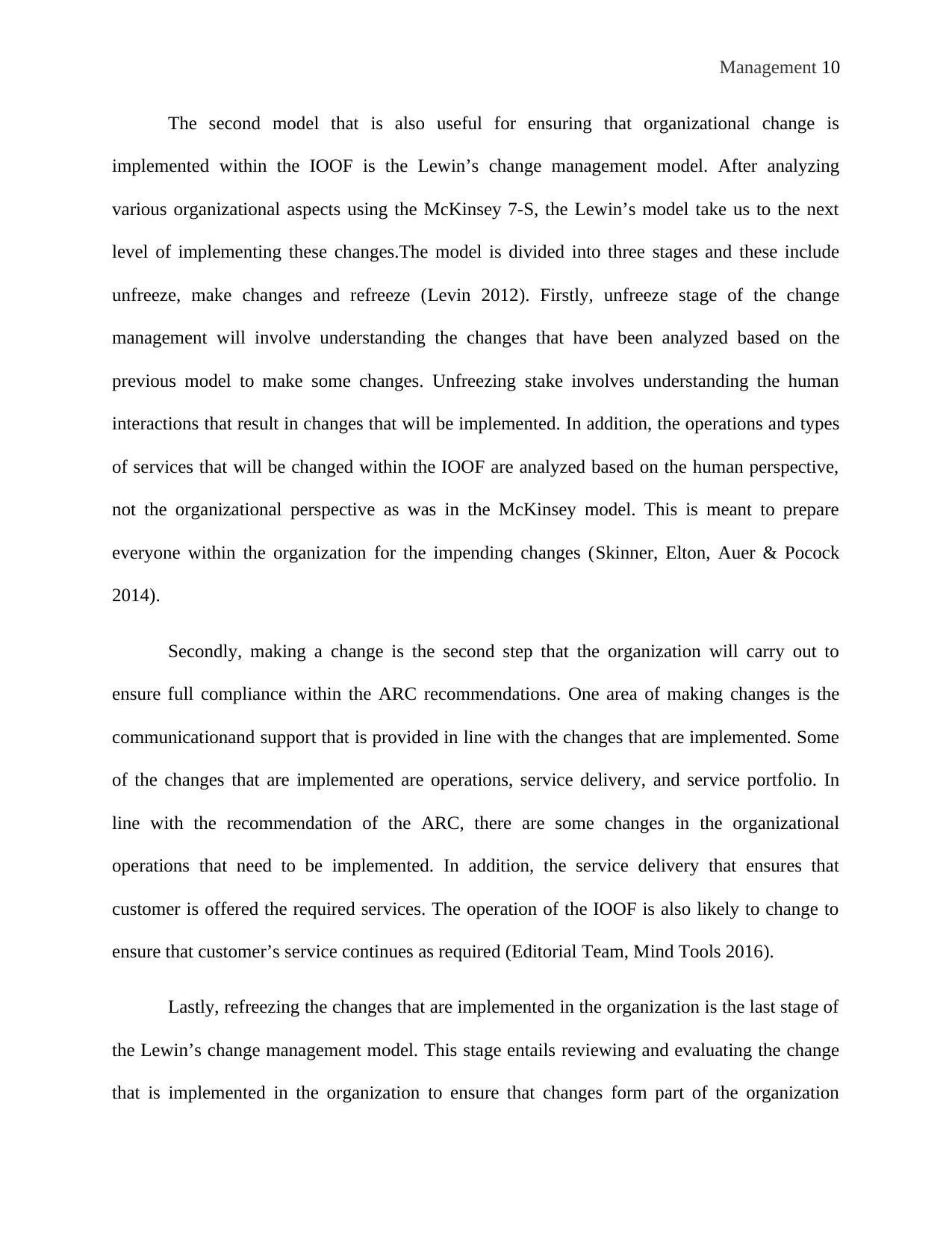
Management 10
The second model that is also useful for ensuring that organizational change is
implemented within the IOOF is the Lewin’s change management model. After analyzing
various organizational aspects using the McKinsey 7-S, the Lewin’s model take us to the next
level of implementing these changes.The model is divided into three stages and these include
unfreeze, make changes and refreeze (Levin 2012). Firstly, unfreeze stage of the change
management will involve understanding the changes that have been analyzed based on the
previous model to make some changes. Unfreezing stake involves understanding the human
interactions that result in changes that will be implemented. In addition, the operations and types
of services that will be changed within the IOOF are analyzed based on the human perspective,
not the organizational perspective as was in the McKinsey model. This is meant to prepare
everyone within the organization for the impending changes (Skinner, Elton, Auer & Pocock
2014).
Secondly, making a change is the second step that the organization will carry out to
ensure full compliance within the ARC recommendations. One area of making changes is the
communicationand support that is provided in line with the changes that are implemented. Some
of the changes that are implemented are operations, service delivery, and service portfolio. In
line with the recommendation of the ARC, there are some changes in the organizational
operations that need to be implemented. In addition, the service delivery that ensures that
customer is offered the required services. The operation of the IOOF is also likely to change to
ensure that customer’s service continues as required (Editorial Team, Mind Tools 2016).
Lastly, refreezing the changes that are implemented in the organization is the last stage of
the Lewin’s change management model. This stage entails reviewing and evaluating the change
that is implemented in the organization to ensure that changes form part of the organization
The second model that is also useful for ensuring that organizational change is
implemented within the IOOF is the Lewin’s change management model. After analyzing
various organizational aspects using the McKinsey 7-S, the Lewin’s model take us to the next
level of implementing these changes.The model is divided into three stages and these include
unfreeze, make changes and refreeze (Levin 2012). Firstly, unfreeze stage of the change
management will involve understanding the changes that have been analyzed based on the
previous model to make some changes. Unfreezing stake involves understanding the human
interactions that result in changes that will be implemented. In addition, the operations and types
of services that will be changed within the IOOF are analyzed based on the human perspective,
not the organizational perspective as was in the McKinsey model. This is meant to prepare
everyone within the organization for the impending changes (Skinner, Elton, Auer & Pocock
2014).
Secondly, making a change is the second step that the organization will carry out to
ensure full compliance within the ARC recommendations. One area of making changes is the
communicationand support that is provided in line with the changes that are implemented. Some
of the changes that are implemented are operations, service delivery, and service portfolio. In
line with the recommendation of the ARC, there are some changes in the organizational
operations that need to be implemented. In addition, the service delivery that ensures that
customer is offered the required services. The operation of the IOOF is also likely to change to
ensure that customer’s service continues as required (Editorial Team, Mind Tools 2016).
Lastly, refreezing the changes that are implemented in the organization is the last stage of
the Lewin’s change management model. This stage entails reviewing and evaluating the change
that is implemented in the organization to ensure that changes form part of the organization
Paraphrase This Document
Need a fresh take? Get an instant paraphrase of this document with our AI Paraphraser
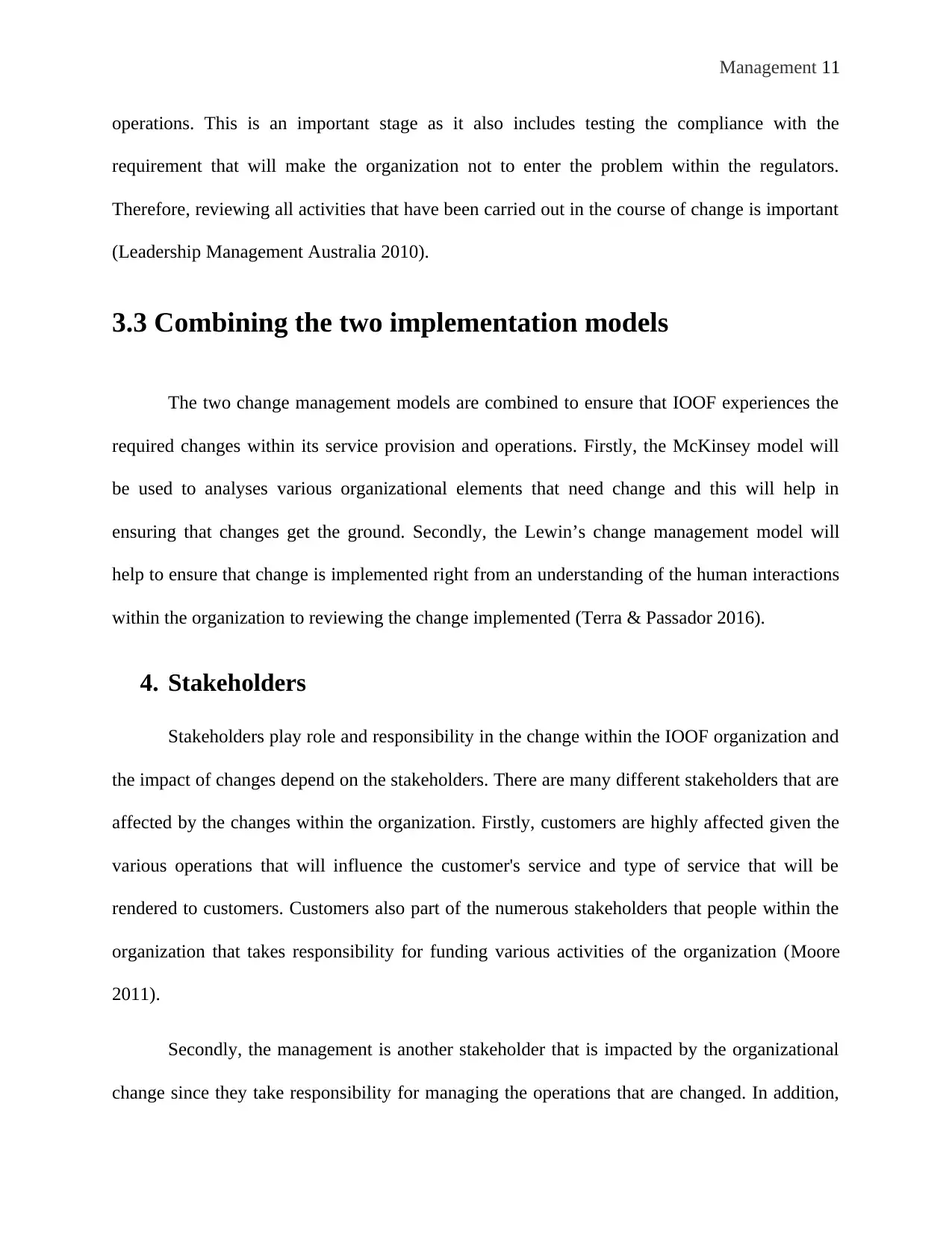
Management 11
operations. This is an important stage as it also includes testing the compliance with the
requirement that will make the organization not to enter the problem within the regulators.
Therefore, reviewing all activities that have been carried out in the course of change is important
(Leadership Management Australia 2010).
3.3 Combining the two implementation models
The two change management models are combined to ensure that IOOF experiences the
required changes within its service provision and operations. Firstly, the McKinsey model will
be used to analyses various organizational elements that need change and this will help in
ensuring that changes get the ground. Secondly, the Lewin’s change management model will
help to ensure that change is implemented right from an understanding of the human interactions
within the organization to reviewing the change implemented (Terra & Passador 2016).
4. Stakeholders
Stakeholders play role and responsibility in the change within the IOOF organization and
the impact of changes depend on the stakeholders. There are many different stakeholders that are
affected by the changes within the organization. Firstly, customers are highly affected given the
various operations that will influence the customer's service and type of service that will be
rendered to customers. Customers also part of the numerous stakeholders that people within the
organization that takes responsibility for funding various activities of the organization (Moore
2011).
Secondly, the management is another stakeholder that is impacted by the organizational
change since they take responsibility for managing the operations that are changed. In addition,
operations. This is an important stage as it also includes testing the compliance with the
requirement that will make the organization not to enter the problem within the regulators.
Therefore, reviewing all activities that have been carried out in the course of change is important
(Leadership Management Australia 2010).
3.3 Combining the two implementation models
The two change management models are combined to ensure that IOOF experiences the
required changes within its service provision and operations. Firstly, the McKinsey model will
be used to analyses various organizational elements that need change and this will help in
ensuring that changes get the ground. Secondly, the Lewin’s change management model will
help to ensure that change is implemented right from an understanding of the human interactions
within the organization to reviewing the change implemented (Terra & Passador 2016).
4. Stakeholders
Stakeholders play role and responsibility in the change within the IOOF organization and
the impact of changes depend on the stakeholders. There are many different stakeholders that are
affected by the changes within the organization. Firstly, customers are highly affected given the
various operations that will influence the customer's service and type of service that will be
rendered to customers. Customers also part of the numerous stakeholders that people within the
organization that takes responsibility for funding various activities of the organization (Moore
2011).
Secondly, the management is another stakeholder that is impacted by the organizational
change since they take responsibility for managing the operations that are changed. In addition,
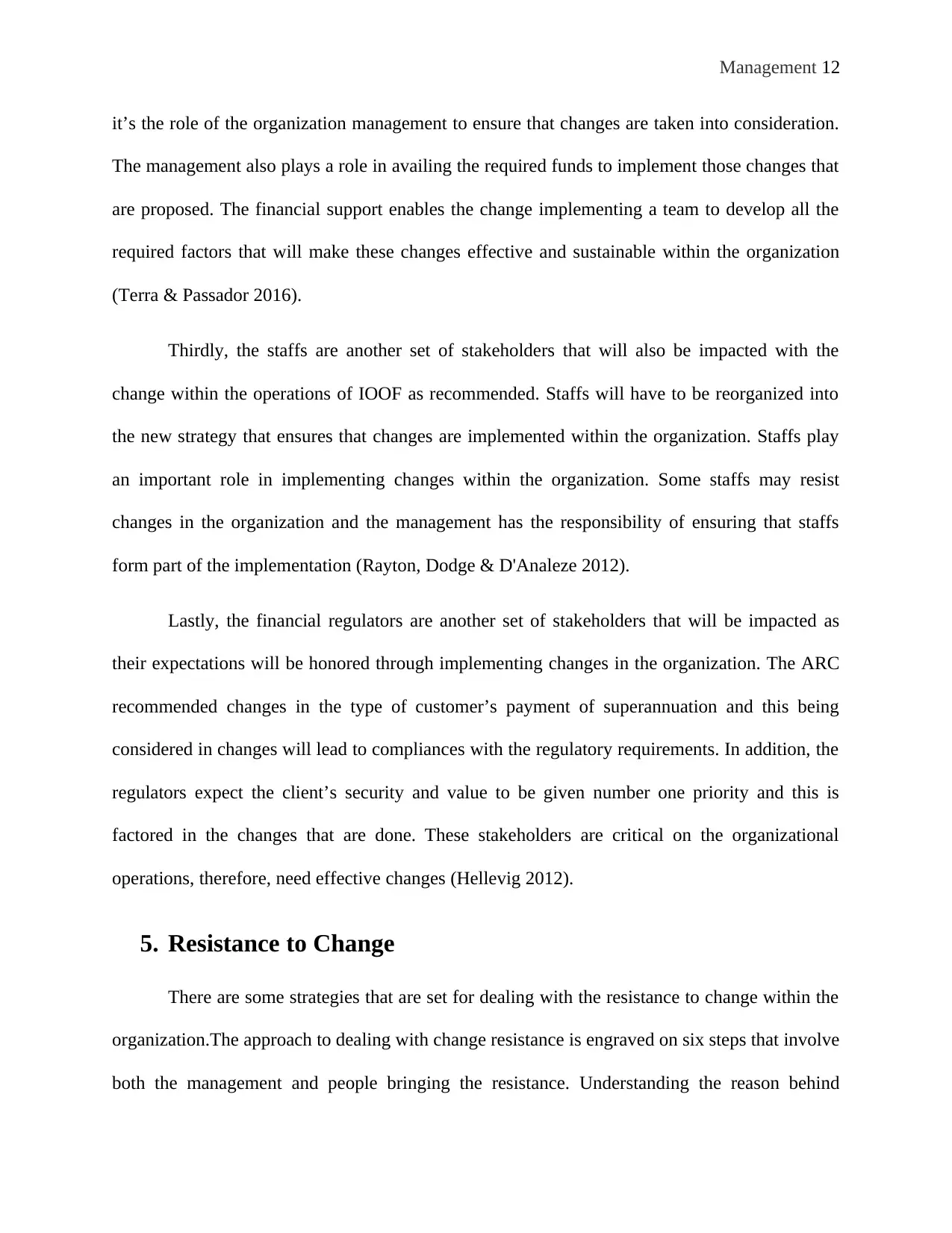
Management 12
it’s the role of the organization management to ensure that changes are taken into consideration.
The management also plays a role in availing the required funds to implement those changes that
are proposed. The financial support enables the change implementing a team to develop all the
required factors that will make these changes effective and sustainable within the organization
(Terra & Passador 2016).
Thirdly, the staffs are another set of stakeholders that will also be impacted with the
change within the operations of IOOF as recommended. Staffs will have to be reorganized into
the new strategy that ensures that changes are implemented within the organization. Staffs play
an important role in implementing changes within the organization. Some staffs may resist
changes in the organization and the management has the responsibility of ensuring that staffs
form part of the implementation (Rayton, Dodge & D'Analeze 2012).
Lastly, the financial regulators are another set of stakeholders that will be impacted as
their expectations will be honored through implementing changes in the organization. The ARC
recommended changes in the type of customer’s payment of superannuation and this being
considered in changes will lead to compliances with the regulatory requirements. In addition, the
regulators expect the client’s security and value to be given number one priority and this is
factored in the changes that are done. These stakeholders are critical on the organizational
operations, therefore, need effective changes (Hellevig 2012).
5. Resistance to Change
There are some strategies that are set for dealing with the resistance to change within the
organization.The approach to dealing with change resistance is engraved on six steps that involve
both the management and people bringing the resistance. Understanding the reason behind
it’s the role of the organization management to ensure that changes are taken into consideration.
The management also plays a role in availing the required funds to implement those changes that
are proposed. The financial support enables the change implementing a team to develop all the
required factors that will make these changes effective and sustainable within the organization
(Terra & Passador 2016).
Thirdly, the staffs are another set of stakeholders that will also be impacted with the
change within the operations of IOOF as recommended. Staffs will have to be reorganized into
the new strategy that ensures that changes are implemented within the organization. Staffs play
an important role in implementing changes within the organization. Some staffs may resist
changes in the organization and the management has the responsibility of ensuring that staffs
form part of the implementation (Rayton, Dodge & D'Analeze 2012).
Lastly, the financial regulators are another set of stakeholders that will be impacted as
their expectations will be honored through implementing changes in the organization. The ARC
recommended changes in the type of customer’s payment of superannuation and this being
considered in changes will lead to compliances with the regulatory requirements. In addition, the
regulators expect the client’s security and value to be given number one priority and this is
factored in the changes that are done. These stakeholders are critical on the organizational
operations, therefore, need effective changes (Hellevig 2012).
5. Resistance to Change
There are some strategies that are set for dealing with the resistance to change within the
organization.The approach to dealing with change resistance is engraved on six steps that involve
both the management and people bringing the resistance. Understanding the reason behind
⊘ This is a preview!⊘
Do you want full access?
Subscribe today to unlock all pages.

Trusted by 1+ million students worldwide
1 out of 21
Related Documents
Your All-in-One AI-Powered Toolkit for Academic Success.
+13062052269
info@desklib.com
Available 24*7 on WhatsApp / Email
![[object Object]](/_next/static/media/star-bottom.7253800d.svg)
Unlock your academic potential
Copyright © 2020–2025 A2Z Services. All Rights Reserved. Developed and managed by ZUCOL.





